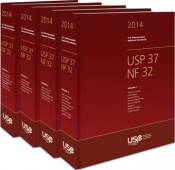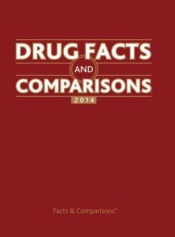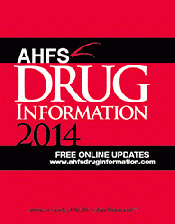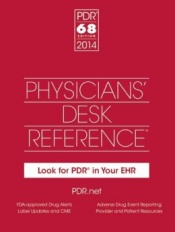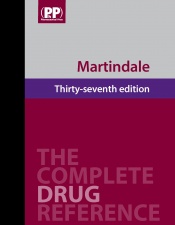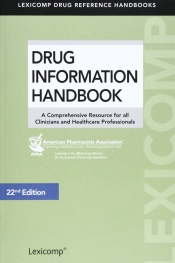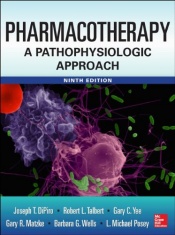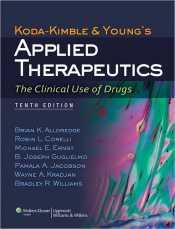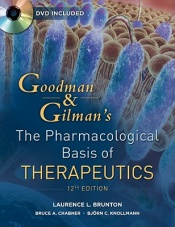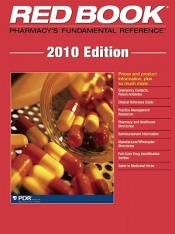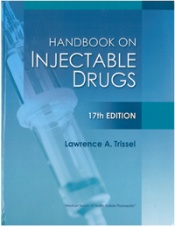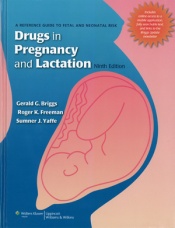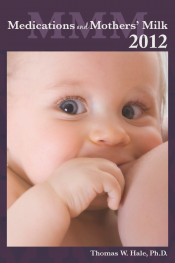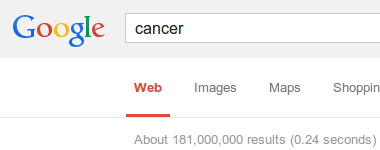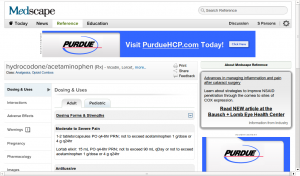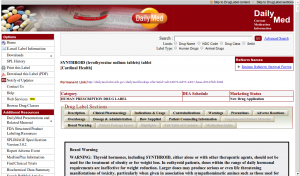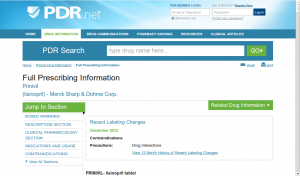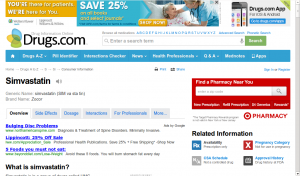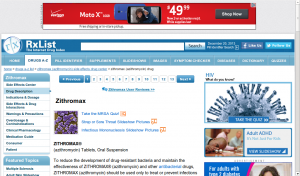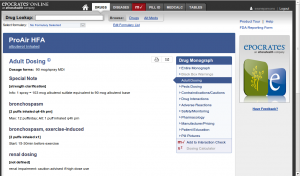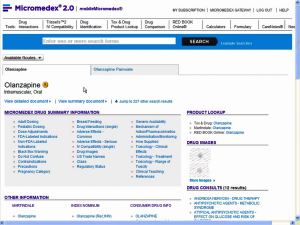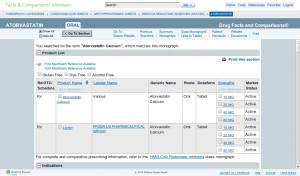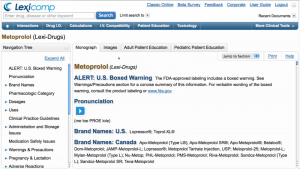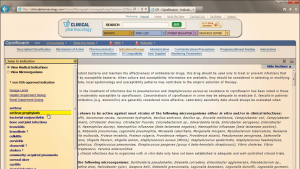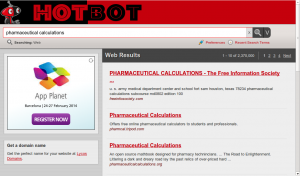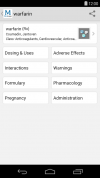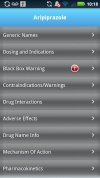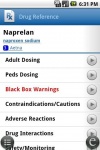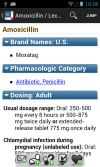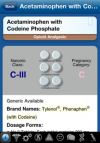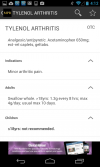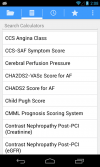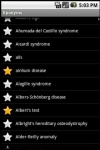Drug information resources
From Rx-wiki
Various types of pharmacy publications and references have different characteristics. These can typically be broken into categories based on the following criteria:
- pharmacy literature which is based on how far removed it is from the original research (primary, secondary, and tertiary); and
- material based on format (books, articles, websites, etc.).
This article provides an overview of these types of resources along with some commonly used references. The mention of any particular reference is not intended as an official endorsement, but simply recognition of its common use.
Contents
- 1 Legal aspects
- 2 Pharmacy literature
- 3 Common references
- 3.1 Printed references
- 3.1.1 Drug Facts and Comparisons
- 3.1.2 AHFS Drug Information
- 3.1.3 Physician's Desk Reference
- 3.1.4 Martindale: The Complete Drug Reference
- 3.1.5 Drug Information Handbook
- 3.1.6 Pharmacotherapy A Pathophysiologic Approach
- 3.1.7 Applied Therapeutics: The Clinical Use of Drugs
- 3.1.8 Goodman and Gilman's Pharmacological Basis of Therapeutics
- 3.1.9 Red Book: Pharmacy's Fundamental Reference
- 3.1.10 Handbook on Injectable Drugs
- 3.1.11 King Guide to Parenteral Admixtures
- 3.1.12 Drugs in Pregnancy and Lactation
- 3.1.13 Medications and Mothers' Milk
- 3.2 Online references
- 3.2.1 The pros & cons of online health care information
- 3.2.2 Evaluating information from online resources
- 3.2.3 Online resources for professionals
- 3.2.4 Online resources for patients
- 3.2.5 Mollifying biased search engine results
- 3.2.6 Dispelling online rumors and hoaxes
- 3.3 Smartphone and tablet applications
- 3.1 Printed references
- 4 Additional external resources
- 5 See also
- 6 References
Legal aspects
Pharmacies should be aware of any requirements made of them with respect to reference materials, both to avoid any citations for noncompliance and in order to provide an appropriate level of assurance that they are providing proper medication therapy.
Federal requirements
On the federal level, there are currently no specified requirements for pharmaceutical references. The federal government has opted to leave these requirements up to each state.
The United State Pharmacopeia and National Formulary (USP-NF, also commonly referred to simply as USP) is a publication about prescriptions and over-the-counter medicines and other healthcare products sold in the United States. Pharmacies and pharmaceutical manufacturers are required to follow the standards in the USP-NF. The USP also sets standards for food ingredients and dietary supplements. Chapters in the USP that are listed as below 1000 are considered enforceable, while chapters enumerated as 1000 or greater are considered guidelines. Therefore, USP <797> Pharmaceutical Compounding-Sterile Preparations and USP <795> Pharmaceutical Compounding-Nonsterile Preparations are considered enforceable, while USP <1075> Good Compounding Practices and USP <1160> Pharmaceutical Calculations in Prescription Compounding are simply considered guidelines for best practices. A challenge to enforcement is that the USP does not have its own enforcement body. Enforcement of various regulations is left to the Food and Drug Administration, The Joint Commission, and individual state boards of pharmacy. This means that many regulations may not be enforced in some states and territories.State requirements
States, as would be expected have a wide variety of requirements, depending on which state you are in, and what kind of practice setting you are in (community, institutional, mail order, etc.). To let's look at the reference requirements for Pennsylvania and California in order to get an idea of what states require.
Pennsylvania Chapter 27 State Board of Pharmacy:
An adequate reference library which meets the following standards:
(i) Enables a pharmacy to prepare and dispense prescriptions properly, consistent with its scope of practice.
(ii) Includes reference sources appropriate to the type of pharmacy practice at that particular location. A pharmacy shall include in the pharmacy’s library current material regarding the technical, clinical and professional aspects of practice with emphasis in the area in which the pharmacy specializes.
(iii) Enables the pharmacist to compound medications in a safe and effective manner consistent with accepted standards of pharmacy practice.
(iv) Lists the possible drug interactions and possible adverse effects of medications dispensed by the pharmacy.
(v) Lists the therapeutic equivalents for medications.
(vi) Lists the therapeutic usage and dosages of medications dispensed by the pharmacy.
(vii) Provides guidelines for the counseling of patients.
(viii) A pharmacy that specializes in nuclear or parenteral prescriptions may limit the library it maintains under subparagraph (ii) relating to the pharmacy’s own specialization.
(ix) Maintains the latest editions including current supplements of each of its reference sources.
California 2013 Lawbook for Pharmacy:
1751.8. Sterile Injectable Compounding Reference Materials.
In any pharmacy engaged in compounding sterile injectable drug products, there shall be current and appropriate reference materials regarding the compounding of sterile injectable products located in or immediately available to the pharmacy.
Whichever state(s) your pharmacy is practicing in, make sure your pharmacy is in compliance.
Pharmacy literature
Scholarly fields, such as pharmacy, requires much research, means for cataloging/indexing the research, and eventually compilations from the various research studies. All aspects should involve competent professionals capable of properly interpreting the information.
Primary
Primary literature provides direct access to the most current information resulting from contemporary research. It is the largest and most current source of information. This type of literature includes original reports of scientific, clinical, technological, and administrative research projects and studies.
Examples of primary pharmacy literature includes peer reviewed journals such as the New England Journal of Medicine (http://www.nejm.org), the American Journal of Health-System Pharmacy (http://www.ajhp.org), and the International Journal of Pharmaceutical Compounding (http://www.ijpc.com). For additional pharmacy journals, a list of popular pharmacy journals can be found at http://www.pharmacy.org/journal.html.
Secondary
Secondary literature involves the interpretation and evaluation of information derived from or in reference to the primary literature sources. This secondary literature takes the primary literature and synthesizes, generalizes, and integrates new research.
Examples of secondary literature includes review articles, systematic reviews, meta-analyses and reference works. Secondary literature also includes indexing and abstracting services. PubMed (http://www.ncbi.nlm.nih.gov/pubmed) and The Cochrane Library (http://www.thecochranelibrary.com) are common examples of secondary literature.
Tertiary
Tertiary literature references are condensed works based on primary and secondary literature, such as textbooks, encyclopedia articles, and guidebooks or handbooks. The purpose of tertiary literature is to provide an overview of key research findings and an introduction to principles and practices. These are the types of references most commonly used in both the classroom and pharmacy environment.
Some common examples of these are the Drug Information Handbook (http://webstore.lexi.com/Drug-Information-Handbook), Micromedex (http://www.micromedex.com), and Drug Facts and Comparisons (http://www.factsandcomparisons.com).
Common references
Depending on the types of information specifically needed, along with accessibility and individual preference, a particular format or specific resource may be better suited. With that in mind there are numerous books, websites, and dedicated applications to help ensure that professional have access to the necessary information. The listing below are not intended to be exhaustive, but simply to detail some of the more commonly used references.
Printed references
Print references usually offer some reasonable advantages over other types of media in that they are available off-line, relatively easy to navigate, and a format that most people are comfortable using. Conversely, a disadvantage is that most of them are limited to annual updates (although some publish monthly updates that would need to be inserted). In a dynamic field like pharmacy this can be a concern. As you read through the list, you will find it very common that many of the books listed offer varios electronic tools/versions (eBooks, web sites, mobile apps, and database integration).
Some of the books listed below are very broad in subject matter (Drug Facts and Comparisons) while others are more specialized in their content (Drugs in Pregnancy and Lactation). As previously mentioned, any references listed are not intended as recommendations, but are simply being highlighted because they are commonly used.
Drug Facts and Comparisons
The Drug Facts and Comparisons provides the following drug information:
- medication availability,
- drug formulations,
- general dosing guidelines,
- adverse drug reactions,
- phamacokinetics,
- drug interactions,
- general pharmacology,
- indications,
- over the counter drugs,
- the alcohol content of drugs, and
- sugar-free liquid preparations.
The Drug Facts and Comparisons also provides information on manufacturers' phone numbers and diagnostic aids. The print version can receive monthly updates to ensure current content. There is also an online version of this available as a subscription service. The online version is discussed further in the online drug information resource section.
AHFS Drug Information
The AHFS Drug information (AHFS DI) provides the following drug information:
- medication availability,
- drug formulations,
- general dosing guidelines,
- adverse drug reactions,
- drug interactions,
- general pharmacology,
- indications,
- over the counter drugs,
- unlabelled (off-label) uses, and
- immunizations.
The AHFS Drug information is broken into sections divided by drug classifications. The print version is updated annually with a new edition. It is also available through online subscription and through specific apps for Android and iOS.
Physician's Desk Reference
The Physician's Desk Reference (PDR) provides the following drug information:
- approved FDA product information equivalent to package insert,
- general pharmacology,
- indications and usage,
- adverse drug reactions,
- drug interactions, and
- dosage and administration
- tablet and capsule identification, and
- the manufacturer's telephone numbers.
The Physician's Desk Reference effectively prints the information approved by the FDA for the package insert. The PDR is also available online at http://www.pdr.net, and for various smartphones and tablets (Android, BlackBerry, and iOS).
Martindale: The Complete Drug Reference
The Martindale: The Complete Drug Reference provides drug information on:
- drug availability,
- formulations,
- general dosing,
- investigational drugs,
- manufacturer information,
- foreign drugs,
- compatibility,
- adverse drug reactions, and
- efficacy of drug therapy.
Besides pharmaceuticals, the Martindale also covers herbals, diagnostic agents, radiopharmaceuticals, pharmaceutical excipients, toxins, and poisons.
Drug Information Handbook
The Drug Information Handbook provides drug information on:
- drug availability,
- formulations,
- general dosing,
- adverse drug reactions,
- pharmacokinetics,
- drug interactions,
- general pharmacology,
- and indications.
The Drug Information Handbook is updated annually and is conveniently organized alphabetically by generic drug names with cross-references from common brand names. It is also available as an app for Android, BlackBerry, and iOS. The publisher of the Drug Information Handbook, Lexicomp, also provides an online version at http://online.lexi.com.
Pharmacotherapy A Pathophysiologic Approach
Pharmacotherapy A Pathophysiologic Approach provides information on:
- disease state and appropriate drug therapy including:
- diagnostic flow diagrams,
- treatment algorithms,
- dosing guideline recommendations,
- monitoring approaches, and
- evaluation of therapeutic outcomes
- details disease signs and symptoms
- covers clinical controversies
- includes pharmacoeconomic issues/concerns
- discusses challenges with patient compliance
This is highly detailed therapeutic text is available in both a traditional printed format and as an ebook.
Applied Therapeutics: The Clinical Use of Drugs
Applied Therapeutics: The Clinical Use of Drugs provides information on:
- drug therapeutics including:
- comparative drug information,
- pharmacokinetic properties,
- dosing guidelines, and
- risk factors
- disease information including:
- common disease and disorder diagnosis information,
- treatment options (including drug regimens),
- risk factors, and
- Q & A sections for major disease states
The information in this textbook is often provided through the use of case studies in the attempt to provide demonstrative examples of patient care and the challenges associated therein.
Goodman and Gilman's Pharmacological Basis of Therapeutics
The Goodman and Gilman's Pharmacological Basis of Therapeutics covers the following nine categories:
- general principles
- neuropharmacology
- modulation of cardiovascular function
- inflammation, immunomodulation, and hematopoiesis
- endocrine pharmacology
- gastrointestinal pharmacology
- chemotherapy of infectious disease
- chemotherapy of neoplastic diseases
- special systems pharmacology
Goodman and Gilman's Pharmacological Basis of Therapeutics is the "Gold Standard" for pharmacology textbooks; although, it is deficient on information for clinical application. This is available as both a printed book and as an ebook. Some concern has been expressed over the legibility of the charts and tables contained within the ebook version.
Red Book: Pharmacy's Fundamental Reference
Red Book: Pharmacy's Fundamental Reference provides information on:
- average wholesale drug prices for over 100,000 prescription drugs, OTC drugs, and medical supply items,
- direct purchasing prices on many pharmaceuticals,
- general availability of drugs,
- availability of sugar-free liquid preparations,
- tablet and capsule identification, and
- manufacturers telephone numbers and addresses.
This product is also available on CDROM for MS Windows and an online version is available as well. The Red Book can be integrated into the Micromedex online subscription service as both products are available through Truven Health Analytics. While the various electronic versions have continued to receive updates, the print edition has not been updated since 2010.
Handbook on Injectable Drugs
Handbook on Injectable Drugs (often referred to as Trissel's Handbook on Injectable Drugs or simply the Trissel due to the books primary author, Lawrence Trissel) provides information on:
- multisource/ingredient compatibility and stability of parenteral admixtures when mixed directly and when mixing only in an infusion set,
- information for safe/appropriate rates of administration,
- monographs on
- storage,
- preparation,
- concentration,
- pH,
- dosing, and
- administration.
The information from this product is available in multiple formats including print, online via a subscription, and for mobile devices including Android and iOS. This product can also be integrated into the online version of Facts and Comparisons.
King Guide to Parenteral Admixtures
King Guide to Parenteral Admixtures (a.k.a., Cutter Guide) provides information on:
- contains information on over 500 drugs in 12 different diluents,
- compatibility and stability of drugs and solutions by route of administration, and
- charts for every medication that provide easy view of the information.
This product is available in an array of formats including a loose leaf print edition that receives quarterly updates, various mobile devices including Android and iOS, online, and it can be integrated into other pharmacy databases. Wall charts of information from this publication are also available to help with many common stability and compatibility questions.
Drugs in Pregnancy and Lactation
Drugs in Pregnancy and Lactation (also sometimes simply referred to as Briggs, due to the last name of the book's lead author) provides information on:
- drug monographs containing:
- generic name,
- pharmacologic class,
- risk factor(s),
- fetal risk summary, and
- breast feeding summary,
- cross referenced combination drugs,
- lists of drugs contraindicated in breastfeeding, and
- lists of drugs contraindicated in pregnancy.
This book is available in traditional print and in various eBook formats. A companion website aids in keeping information current and adds another level of search capabilities. The book also comes with a free mobile app that has limited functionality, but can be upgraded from within the app.
Medications and Mothers' Milk
Medications and Mothers' Milk(also sometimes simply referred to as Hale, due to the last name of the book's lead author) provides information on:
- the effects of numerous drugs expressed in breast milk including:
- legend drugs,
- chemotherapeutic agents,
- radiopharmaceuticals,
- vaccines,
- over the counter drugs, and
- herbals,
- various syndromes that effect lactation,
- radiocontrast agents, and
- various quick reference tables/charts.
This publication is typically updated every two years. Hale Publishing also maintains an online database with this information as a subscription service available for both individual and institutional subscriptions.
Online references
There is a vast amount data related to health care available through the internet. With that in mind, there are several things that should be looked at in this section:
- the pros & cons of health care information available on the internet
- how to properly evaluate the claims and statements made by various websites
- good online resources for students and professionals
- easy to understand and reliable online resources for patients
- contending with the potential bias of a particular search engine
- dispelling online rumors/hoaxes concerning health care
The pros & cons of online health care information
Of the approximately 313,000,000 people living in the United States, over 245,000,000 use the internet. Many of these Americans regularly use the internet to research health related information with an over abundance of sites offering medical information. If someone does a general online search for the word “cancer”, a voluminous number of results will appear in the results (about 181,000,000).
With this high degree of information accessibility, brief lists of the 'Pros & Cons' can be made for looking up health care information via the internet.
| Pros | Cons |
|
|
As we move forward in this article, we will look for ways to manage some of these 'cons'.
Evaluating information from online resources
When evaluating online resources it is useful for sites to follow best practices as described by Healthcare On the Net (HON), but if all these policies are not necessarily in place there are also 'red flags' to warn you of inappropriate information.
Best practices
Health On the Net (HON) provides 8 principles for its code of conduct for medical and health related web sites. These principles are commonly identified as best practices. Listed below are their 8 principles.
- Authoritative - Indicate the qualifications of the authors
- Complementarity - Information should support, not replace, the doctor-patient relationship
- Privacy - Respect the privacy and confidentiality of personal data submitted to the site by the visitor
- Attribution - Cite the source(s) of published information, date and medical and health pages
- Justifiability - Site must back up claims relating to benefits and performance
- Transparency - Accessible presentation, accurate email contact
- Financial disclosure - Identify funding sources
- Advertising policy - Clearly distinguish advertising from editorial content
Red Flags to spot noncredible web sites
While the best practices mentioned above is a good way to identify a quality information resource, it is also important to be able to identify the traits of noncredible resources. The following is a short list:
- Lacking contact information or an "About Us" section
- No reference to updates
- No disclaimer (eg, "This is not meant to be medical advice...")
- Claiming a scientific breakthrough or ancient or miraculous cures
- Claiming that a product is effective for a wide range of ailments
- Undocumented case histories
- Missing references or citing only unpublished or obscure studies
- Product available from only one source, with a money-back guarantee
- Lacking links to endorsed and generally accepted sites
Online resources for professionals
There are a number of free and subscription based web sites available for health care professionals, particularly for pharmacists and pharmacy technicians. In this article we will once again focus on resources commonly used by pharmacy students and professionals. A particular site being listed in this article is not necessarily a particular endorsement for a web site, but is instead a recognition of its frequent use.
Free websites
By free, this only implies that it requires no monetary remuneration by individual users. Some of these sites require free registration, and most also include advertising to cover their costs.
Medscape
Medscape - http://medscape.com/ - is a free web resource (registration required) for health professionals. It includes:
- peer-reviewed original medical journal articles,
- Continuing Medical Education (CME),
- a customized version of the National Library of Medicine's MEDLINE database,
- daily medical news,
- major conference coverage, and
- drug information including:
- drug monographs,
- patient handouts,
- drug prices,
- medication images, and
- a drug interaction checker.
Medscape also provides a mobile app both Android and iOS.
DailyMed
DailyMed - http://dailymed.nlm.nih.gov/ - is a website operated by the U.S. National Library of Medicine (NLM) to publish up-to-date and accurate labels (package insert) for health care providers and the general public. The contents of DailyMed is provided and updated daily by the U.S. Food and Drug Administration (FDA). The FDA in turn collects this information from the pharmaceutical industry. As of January 3rd, 2014 it contains 58,383 package inserts (23,490 prescription labels, 26,780 OTC labels, 4,932 homeopathic labels, 1,646 animal labels, and 1,535 labels for bulk ingredients, vaccines, and some medical devices). DailyMed also provides an RSS for updated drug information.
PDR.net
PDR.net - http://www.pdr.net/ - provides the same information as the printed version of the PDR, with the significant improvement that it is updated regularly. The site also provides:
- downloadable PDF of the PDR,
- drug alerts,
- drug recalls,
- drug approvals, and
- access to articles on various clinical trials.
There are also PDR apps available for Android and iOS.
Drugs.com
Drugs.com - http://www.drugs.com/ - provides the following:
- drug monographs,
- a pill identifier,
- interactions checker,
- the ability to look up medications phonetically, and
- drug news such as:
- recalls,
- alerts,
- labeling changes, and
- new drug approvals.
Drugs.com has both paid for and free apps available for Android and iOS.
RxList
RxList - http://www.rxlist.com/ - provides the following information:
- drug monographs,
- pronunciation keys and audio files providing proper pronunciation,
- a pill identifier,
- a dictionary with both medical terminology and medical abbreviations,
- various health related slide shows,
- a symptom checker, and
- various quizzes.
Epocrates
Epocrates - http://www.epocrates.com/ - is a free web resource (registration required) for health professionals. It provides the following information:
- drug monographs,
- disease look-up,
- drug interaction checker,
- pill identifier,
- various drug dosage calculators, and
- various comparison tables.
Epocrates has also had apps available for most mobile platforms.
Websites requiring paid subscriptions
Subscription sites do offer some advantages when compared to free websites. There is a general perception that these subscription websites offer more information. There is a commonly held belief that they are less likely to inappropriately bias individuals through advertising since ads are not included in search results. Also, there is generally the ability to subscribe to additional databases that may be useful to your facility based on the kinds of patients that are being served.
These subscription sites usually require contracts which are based on various items including corporate vs individual user licenses, the number of people that will be provided direct access to the program, educational rates compared to rates for healthcare facilities. As these rates can be complex to determine, specific costs will not be discussed in this article.
The four subscription websites (Micromedex, Facts and Comparisons eAnswers, Lexicomp Online, and Clinical Pharmacology) mentioned in this article are among the most commonly used drug information subscription services.
Micromedex
Micromedex - http://www.micromedex.com/ - provides access to the following information:
- drugs monographs for legend drugs and OTC medications,
- drug interaction checker,
- toxicology,
- medical calculators,
- drug identification,
- formulary information,
- average wholesale price of medications,
- disease and condition reference,
- procedure reference,
- laboratory tests,
- alternative medicine information for herbals and dietary supplements,
- compatibility information on injectables, and
- patient educational materials.
Micromedex also provides (for additional cost) access to the following list of add-on modules:
- Martindale: The Complete Drug Reference,
- NeoFax,
- Thomson Reuters Pediatrics,
- Index Nominum,
- Herbal Medicines,
- Kinetidex, and
- ReproRisk.
Facts and Comparisons eAnswers
Facts and Comparisons eAnswers - http://online.factsandcomparisons.com - is the web based alternative to maintaining the paper based Drug Facts and Comparisons, and it also provides additional features not available in the print edition. Facts and Comparisons eAnswers provides access to the following information:
- medication availability,
- drug formulations,
- general dosing guidelines,
- adverse drug reactions,
- phamacokinetics,
- drug interactions,
- allergy screening,
- general pharmacology,
- indications,
- over the counter drugs,
- the alcohol content of drugs,
- sugar-free liquid preparations,
- comparative drug tables,
- pill identification
- patient counselling/education notes,
- Risk Evaluation and Mitigation Strategy (REMS) summaries, and
- Patient Assistance Program information.
Facts and Comparisons eAnswers also provides (for additional cost) access to the following list of add-on modules:
- Trissel's IV-Chek,
- Toxicology Treatment Guidelines,
- The Formulary Monograph Service,
- Martindale: The Complete Drug Reference,
- Drug Plans, and
- HL7 InfoButton.
Lexicomp Online
Lexicomp Online - http://online.lexi.com - provides access to the following information:
- drug monographs,
- pharmacologic category,
- drug formulations,
- general dosing guidelines,
- pediatric dosing guidelines,
- geriatric dosing guidelines,
- adverse reactions,
- contraindications,
- keyword search for charts/special topics,
- drug interactions,
- drug indications,
- warnings/precautions,
- NDC look-up,
- methodology based on laboratory tests,
- manufacturer information for brand drugs,
- new drug approval information,
- special alerts,
- drug identification,
- drug calculators,
- IV compatibility,
- patient care packet creator,
- drug plan information,
- toxicology,
- disease database, and
- international drug database.
Clinical Pharmacology
Clinical Pharmacology - http://www.clinicalpharmacology.com/ - provides access to the following information:
- monographs on:
- U.S. prescription drugs,
- herbals and nutritional,
- OTC products, and
- new and investigational drugs,
- custom reports for:
- multi-drug interactions with severity rankings,
- IV compatibility, and
- drug product comparisons,
- drug product information,
- patient education and medication guides,
- drug identification,
- multiple search parameters including:
- an overall site search,
- search by indication,
- adverse reaction,
- classification,
- NDC,
- or manufacturer
- lab references,
- drug manufacturer/distributor contact information, and
- links to drug class overviews.
Clinical Pharamacology also offers various add-on modules that can be used to gain access to additinal databases. Thes add-ons include:
- IV Compatibility Pro powered by Trissel’s 2 Clinical Pharmaceutics Database,
- Clinical Calculators from MedCalc 3000,
- Global Drug Name Directory powered by Index Nominum,
- FormChecker,
- OnFormulary,
- Clinical Pharmacology Toolkit,
- Krames Disease Information for Consumers, and
- Pharmacist's Letter and Natural Medicines Comprehensive Database.
Online resources for patients
The Medical Library Association finds the following web sites particularly useful for people outside of the medical community (sites are listed in alphabetical, NOT ranked, order):
- Cancer.gov
- Centers for Disease Control and Prevention (CDC)
- familydoctor.org
- healthfinder®
- HIV InSite
- Kidshealth®
- Mayo Clinic
- MedlinePlus (English | Spanish)
- NetWellness
- NIH SeniorHealth
The Consumer and Patient Health Information Section (CAPHIS) of MLA evaluates websites based on the following criteria: credibility, sponsorship/authorship, content, audience, currency, disclosure, purpose, links, design, interactivity, and disclaimers.
Mollifying biased search engine results
Whether your preferred search engine is Google, Yahoo!, Bing, or DuckDuckGo none of them identify relevant information perfectly, because each employs different search criteria. Also, most of these engines may prioritize information based on ad revenue, information that may be beneficial to a particular company, or even based on your profile from past searches.When desiring a comprehensive search, many users turn to meta-search engines that employ multiple engines simultaneously. Searches conducted by a meta-search engine will include results from multiple search engines (typically, Google, Yahoo!, Bing, and Yandex). Some popular meta-search engines include Dogpile (http://www.dogpile.com), My Excite (http://www.excite.com), HotBot (http://www.hotbot.com), and Info.com (http://info.com).
Dispelling online rumors and hoaxes
In the constantly connected world of today, we are often inundated with broadcast emails, texts, and tweets on urban health myths warning of imminent health threats. About.com (http://urbanlegends.about.com/library/blxhealth.htm), the CDC (http://www.cdc.gov/hoaxes_rumors.html) and Snopes (http://www.snopes.com/medical/ and http://www.snopes.com/politics/medical/) all maintain websites exposing health-related hoaxes and rumors which may be useful not just to ensure that healthcare professionals have access to the correct information, but so these professionals can direct others to them as well.
Smartphone and tablet applications
Smartphones and tablets have become an increasingly common means for people to receive and interact with data due to their easy portability, high speed internet connectivity, and large array of applications for the most popular platforms.
While numerous mobile operating systems are available on the market today (Android, iOS, Blackberry, Windows, Ubuntu, FirefoxOS, Tizen, Jolla, etc.), the dominant players are Android (used in Nexus, Galaxy, Kindle Fire, etc.) and iOS (used in iPhone, iPad, and iPod Touch).
Various drug information resources have been made available with dedicated apps (short for applications) to be used with the more common operating systems. While hundreds of healthcare related apps have been created for these platforms, this article intends to focus on the ones that are frequently used by pharmacists and pharmacy technicians.
Medscape
The Medscape app provides the following information:
- drug reference for legend drugs, OTC medications, herbals, and supplements,
- drug interaction checker,
- medical calculators,
- formulary information,
- disease and condition reference,
- procedure reference,
- MEDLINE,
- medical news,
- continuing medical education, and
- medical directory.
This app is free (registration required) and is available for both Android (including Kindle Fire) and iOS.
Micromedex
The Micromedex app provides the following drug information:
- brand and generic names,
- therapeutic class,
- black box warnings,
- adult and pediatric dosing guidelines,
- dose adjustments,
- indications (including "off-label" uses),
- administration,
- monitoring,
- how supplied,
- contraindications,
- precautions,
- adverse effects,
- drug interactions,
- pregnancy category,
- breast feeding,
- mechanism of action,
- pharmacokinetics, and
- toxicology.
This app is available for both Android and iOS mobile devices.
Epocrates
The Epocrates app provides the following information:
- drug information for brand, generic, and OTC drugs including:
- adult and pediatric dosing for FDA-approved and off-label indications,
- black box warnings, adverse reactions, and drug interactions,
- healthcare insurance formularies,
- contact information for manufacturers,
- approximate retail drug pricing for patients paying out-of-pocket,
- pregnancy risk categories and lactation safety ratings,
- monitoring parameters and therapeutic drug levels, and
- metabolism, excretion, drug class, and mechanism of action,
- drug interaction checker,
- pill identification tool,
- provider directory,
- anatomy and imaging atlas,
- medication calculators, and
- disease specific resource center.
This app is available for both Android and iOS. The core of this application is available as a free download, but various upgrades are available for this app as well which do require purchase.
Lexicomp
The Lexicomp app provides a 30 day free trial for the following information (although some resources will require either data plan access or wifi):
- drug monographs,
- pharmacologic category,
- drug formulations,
- general dosing guidelines,
- pediatric dosing guidelines,
- geriatric dosing guidelines,
- adverse reactions,
- contraindications,
- keyword search for charts/special topics,
- drug interactions,
- drug indications,
- warnings/precautions,
- NDC look-up,
- methodology based on laboratory tests,
- manufacturer information for brand drugs,
- new drug approval information,
- special alerts,
- drug identification,
- drug calculators,
- IV compatibility,
- patient care packet creator,
- drug plan information,
- toxicology,
- disease database, and
- international drug database.
After the 30-day trial, users can choose from a range of available databases that they wish to continue to access for varying costs. This app is available for both Android and iOS.
Sigler Drug Cards
Sigler Drug Cards is available as an app for the iOS platform (currently not available for other platforms). It provides a study guide with the following information about common drugs:
- full color pictures,
- FDA dosages and Indications,
- pharmacology,
- drug interactions,
- contraindications/precautions,
- adverse effects,
- chemical structures,
- patient consultation tips,
- user notes page,
- color coded class,
- bookmarking capabilities, and
- includes a PDF scrollable version of the “Pocket Index Guide” with:
- Latin abbreviations,
- weights and measures,
- controlled substance schedule,
- normal laboratory values, and
- full cross-reference lists.
Sigler Drug Cards app is expected to include a quiz in the next iteration of their software. This is currently only available as a paid for app.
MPR
MPR (Monthly Prescribing Reference) provides the following information:
- drug monographs for prescription and OTC drugs,
- disease/condition look-up,
- drug manufacturer information
- personalized bookmarks for lists/content
- drug interactions checker for drugs, herbals, supplements, and food,
- medical calculators,
- treatment algorithms, and
- daily drug news and alerts.
This is a free app available for both Android and iOS.
Calculate by QxMD
While Calculate by QxMD is a medical calculator it also provides numerous additional tools, according to QxMD, it contains over 150 medical calculators and decision support tools. These tools fall into the following categories:
- reduce and predict perioperative complications,
- guide treatment,
- determine prognosis,
- dose various medications,
- calculate patient specific data (BSA, IBW, CrCl, etc.),
- classify diseases,
- manage conditions,
- understand causality of certain conditions, and
- aid in diagnosis.
This is a free application available to both Android and iOS.
Eponyms
Sometimes a disease or condition is given a name related to either the individual(s) to first diagnose a disease or its causality (i.e., Alzheimer's disease), or a famous individual that had/has a disease (i.e., Lou Gehrig's disease). Eponyms provides a short description of more than 1,700 common medical eponyms. A simple tool to quickly look up the meaning of many eponyms. It uses the beautiful eponym database from Andrew Yee (http://www.eponyms.net/), and updates can be installed right from within the application.
Eponyms is a free app available to both Android and iOS.
Skyscape Medical Resources
Skyscape provides a platform on top of which numerous resources (over 600) can be made available, some of which are free and others that have varying degrees of costs associated with them. Skyscape Medical Resources comes with the following free applications:
- RxDrugs: Comprehensive information on thousands of brands and generics, with interactions (including multi-drug analyzer tool), pill images and over 400 integrated dosing calculators. This resource also includes formulary information covering 5,000 health plans in all 50 US states.
- Archimedes: Medical calculator with more than 200 interactive tools, organized by specialty.
- Outlines in Clinical Medicine: Evidence-based clinical information on hundreds of diseases and symptom-related topics, presented in convenient outline format.
- MedAlert™: In-context and specialty-focused journal summaries, trial results, breaking clinical news, drug alerts and other information, fully integrated with the app’s global search and SmartLink.
The following is a list of premium resources commonly subscribed to by user of this app:
- 5-Minute Clinical Consult
- Diseases and Disorders: A Nursing Therapeutics Manual
- Davis’s Drug Guide for Nurses
- Rosen and Barkin's 5 Minute Emergency Medicine Consult
- Taber's Cyclopedic Medical Dictionary
- Netter’s Atlas of Human Anatomy
- Fitzpatrick's Color Atlas and Synopsis of Clinical Dermatology
- The Merck Manual of Diagnosis and Therapy
- Diagnostic and Statistical Manual of Mental Disorders
- Journal Watch
This product is available for both Android and iOS.
Additional external resources
If you are interested in additional information on drug information resources, the following is a brief list of external resources worth looking into:
- Medical libraries contain many references and journals that you can peruse and even check out. The library staff have been trained to assist people in searching for specialized materials.
- Additional information for online resources can be found on the Medical Library Association's website at http://www.mlanet.org/resources/.
- IMedicalApps (http://www.imedicalapps.com/) is an up to date resource for medical software for smartphones and tablets running an array of mobile operating systems.
See also
Pharmacology
Patient package insert
References
- Types of Medical Literature, Mercer University Atlanta Swilley LibGuides: Updates to Colleges of Pharmacy and Health Professions Resources, http://mercer.libguides.com/content.php?pid=81289&sid=802112
- CHAPTER 27. STATE BOARD OF PHARMACY, The Pennsylvania Code, http://www.pacode.com/secure/data/049/chapter27/chap27toc.html
- 2013 Lawbook for Pharmacy, California Board of Pharmacy, http://www.pharmacy.ca.gov/laws_regs/lawbook.pdf
- Journals, Virtual Library Pharmacy, http://www.pharmacy.org/journal.html
- Drug Facts and Comparisons, http://www.factsandcomparisons.com/drug-facts-and-comparisons-loose-leaf/
- AHFS Drug Information, http://www.ahfsdruginformation.com/
- Physician's Desk Reference, http://www.pdr.net/
- Martindale: The Complete Drug Reference, http://www.pharmpress.com/product/9780853699330/martindale
- Drug Information Handbook, http://webstore.lexi.com/Drug-Information-Handbook
- Pharmacotherapy A Pathophysiologic Approach, http://accesspharmacy.com/resourceToc.aspx?resourceID=669
- Applied Therapeutics: The Clinical Use of Drugs, http://www.accp.com/bookstore/th_09at.aspx
- Goodman and Gilman's Pharmacological Basis of Therapeutics, http://accessmedicine.com/resourceTOC.aspx?resourceID=651
- Red Book: Pharmacy's Fundamental Reference, http://www.redbook.com/redbook/
- Handbook on Injectable Drugs, http://www.ahfsdruginformation.com/product-hid.aspx
- King Guide to Parenteral Admixtures, https://www.kingguide.com/
- Drugs in Pregnancy and Lactation, http://www.accp.com/bookstore/th_09dpl.aspx
- Medications and Mothers' Milk, http://www.ibreastfeeding.com/catalog/p301/2012-Medications-and-Mothers&%2339-Milk/product_info.html
- Internet Usage and Population in North America, Internet World Stats, http://www.internetworldstats.com/stats14.htm
- Search results for the word "cancer", Google, https://www.google.com/search?q=cancer
- The HON Code of Conduct for medical and health Web sites, Health On the Net, http://www.hon.ch/HONcode/Conduct.html
- Medscape, Wikipedia, http://en.wikipedia.org/wiki/Medscape
- DailyMed, Wikipedia, http://en.wikipedia.org/wiki/DailyMed
- Download, DailyMed, http://dailymed.nlm.nih.gov/dailymed/downloadLabels.cfm
- For Health Consumers: "Top Ten" Most Useful Websites, Medical Library Association, http://www.mlanet.org/resources/medspeak/topten.html
- Facts and Comparisons eAnswers (Online), http://www.factsandcomparisons.com/facts-comparisons-online/
- Lisa Homburg, R.Ph., College of Mainland representative, material assistance provided January 9, 2014
- Medscape Mobile App, http://www.medscape.com/public/mobileapp
- Micromedex Drug Information, https://play.google.com/store/apps/details?id=com.thomson.druginfo
- Lexicomp Online User Guide, Lexicomp, http://www.lexi.com/institutions/products/online/files/user-guide.pdf
- Clinical Pharmacology, http://www.clinicalpharmacology.com/
- Epocrates Rx, Epocrates, http://epocrates.com/mobile/iphone/rx
- Lexicomp app, https://play.google.com/store/apps/details?id=com.lexi.android
- Sigler Drug Cards app, http://www.siglerdrugcards.com/index.php?option=com_content&view=article&id=14&Itemid=90
- Skyscape Medical Resources, https://play.google.com/store/apps/details?id=com.skyscape.android.ui
- Eponyms, https://play.google.com/store/apps/details?id=net.eponyms
- Calculate by QxMD, https://play.google.com/store/apps/details?id=com.qxmd.calculate
